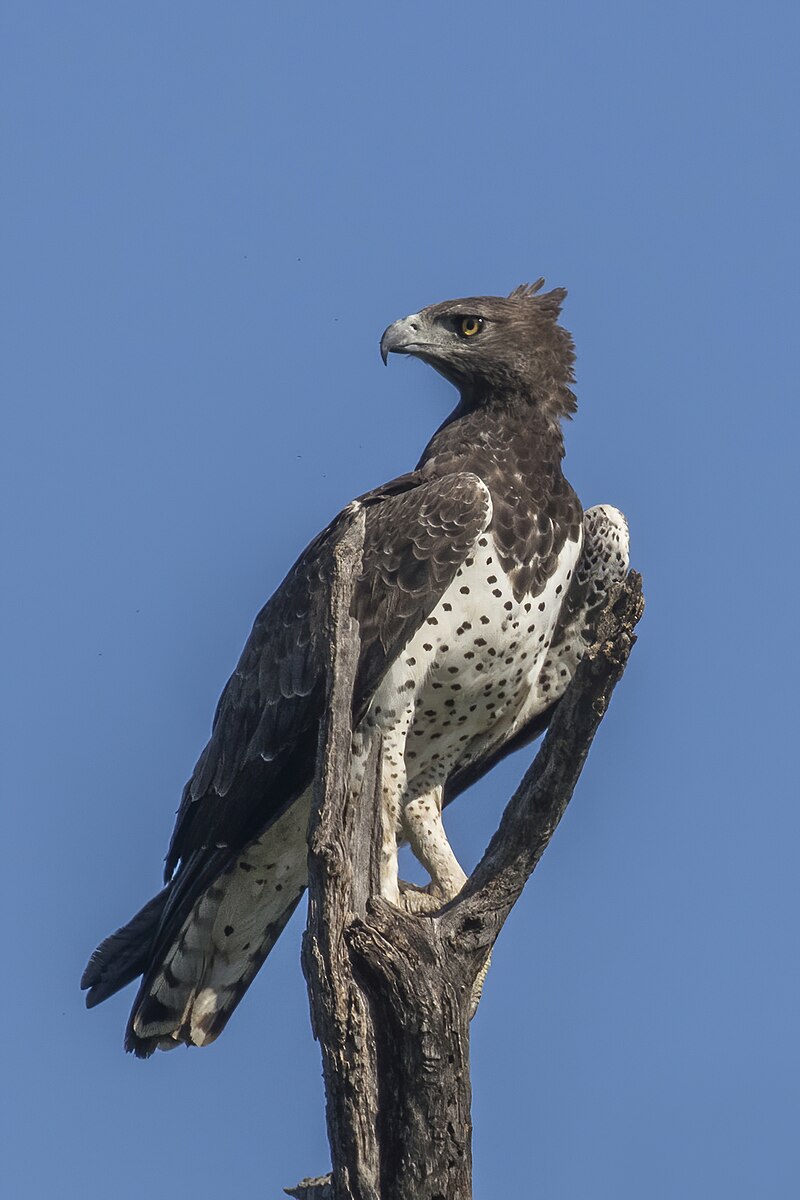Martial eagles (Polemaetus bellicosus) are large birds of prey found in Sub-Saharan Africa, known for their size, power, and distinctive plumage. These impressive raptors are monogamous and mate for life, forming pairs that are mostly territorial, with exclusive home ranges that they defend from other adult pairs of the same species.
Martial Eagles’ Mating Behavior
Martial eagles are known to be monogamous, meaning they form long-lasting pair bonds and mate with the same partner for life. This behavior is quite common among birds of prey, as it helps ensure the successful rearing of their young and the defense of their territory.
Pair Formation and Courtship
Martial eagles typically form their pair bonds when they reach sexual maturity, which occurs around six years of age. The courtship process involves elaborate aerial displays, such as soaring, diving, and even locking talons in mid-air. These displays serve to strengthen the pair bond and establish the pair’s territory.
Nesting and Breeding
Once a pair has formed, they will work together to build a large, stick-built nest, often reusing and adding to the same nest year after year. The female martial eagle will lay a single egg, or occasionally two, every two years during the dry season. The incubation period lasts for 47 to 51 days, and the young bird takes about 90 to 109 days to develop and become ready to fledge.
Parental Care and Chick Rearing
Both the male and female martial eagles share the responsibilities of incubating the egg and caring for the chick. The parents will take turns sitting on the nest and providing food for the growing chick. The young martial eagle will remain with its parents for several months after fledging, learning essential hunting and survival skills before eventually dispersing and establishing its own territory.
Martial Eagles’ Hunting and Feeding Habits
 Image source: Martial eagle by Charles J. Sharp
Image source: Martial eagle by Charles J. Sharp
Martial eagles are opportunistic predators, capable of spotting prey from up to 6 km away and hunting on the wing. They have excellent eyesight, which is three to four times that of a human, and spend much of their day soaring at such high heights that they are barely visible, even with binoculars.
Prey Selection
Martial eagles have a diverse diet, preying on a wide range of animals, including mammals, birds, reptiles, and even fruit bats. The specific prey they target can vary depending on the availability and abundance of different species in their habitat.
Hunting Techniques
These impressive raptors are known for their powerful hunting techniques. They often spot their prey from a great height and then attack in a long, slanting stoop, using their sharp talons to capture and kill their target.
Threats and Conservation Efforts
Martial eagles face a variety of threats, including habitat loss, persecution, and collision with power lines, which can cause injuries or death. They are also affected by the decline of their prey species, which can lead to food scarcity and reduced reproductive success. Climate change can also impact their breeding and hunting behavior, as changes in temperature and precipitation patterns can affect the distribution and abundance of their prey.
Habitat Loss and Fragmentation
One of the primary threats to martial eagles is the loss and fragmentation of their natural habitats, which can occur due to factors such as deforestation, urbanization, and agricultural expansion. This can limit the availability of suitable nesting sites and hunting grounds, making it more difficult for these birds to thrive.
Persecution and Human-Eagle Conflicts
Martial eagles are sometimes persecuted by humans, either due to perceived threats to livestock or a lack of understanding about their ecological importance. Collisions with power lines and other infrastructure can also be a significant source of mortality for these birds.
Conservation Efforts
To protect martial eagles, conservation efforts are focused on preserving their natural habitats, reducing human-eagle conflicts, and monitoring their population trends. This includes measures such as habitat restoration, the implementation of wildlife-friendly power line designs, and public education campaigns to raise awareness about the importance of these majestic birds of prey.
Conclusion
In conclusion, martial eagles are remarkable birds that mate for life and play a crucial role in the ecosystems of Sub-Saharan Africa. Their unique hunting abilities, diverse diet, and strong pair bonds make them fascinating subjects of study and conservation. By understanding and protecting these impressive raptors, we can ensure their continued survival and the health of the natural environments they inhabit.
References:
– Animal Diversity Web. Polemaetus bellicosus – Martial eagles. Retrieved from https://animaldiversity.org/accounts/Polemaetus_bellicosus/
– Carnivora. Martial Eagle – Polemaetus bellicosus. Retrieved from https://carnivora.net/martial-eagle-polemaetus-bellicosus-t2414.html
– Owlcation. Everything You Wanted to Know About the Martial Eagle. Retrieved from https://owlcation.com/stem/Birds-of-Prey-The-Martial-Eagle
– SANBI. Martial Eagle. Retrieved from https://www.sanbi.org/animal-of-the-week/35981/.

